When I arrived in US at the age of 19, I had no childhood keepsakes in my two oversized suitcases. My family stayed behind in Ukraine and I thought I could have anything I wanted shipped to me at any time. Life took over and five years later, when my parents were selling our apartment in Kiev to join me in the States, I forgot to ask them about my stuff – random things that had sentimental value for me and me alone. And these things just dissipated in the process.
The only item that made it to New York was a special edition of Grimms Fairy Tales that my father brought me from one of his business trips to Moscow when I was 5. He died from cancer 2 years later.

My husband, who immigrated from Odessa, Ukraine, and whom I met in New York, fared a little better: he still had his collection of toy soldiers, some of his school drawings, and few of his favorite children’s books.
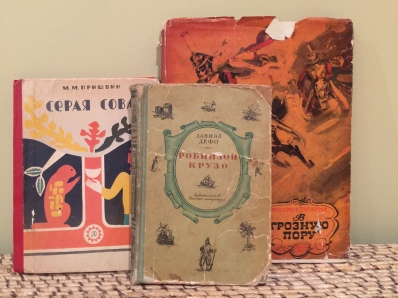
When we merged our homes after the wedding, he also handed me a blue cotton shirt his mother sewed for him when he was a baby. When our daughter was 6 months old, we dressed her up in this heirloom shirt and took some precious photos. Like this one.
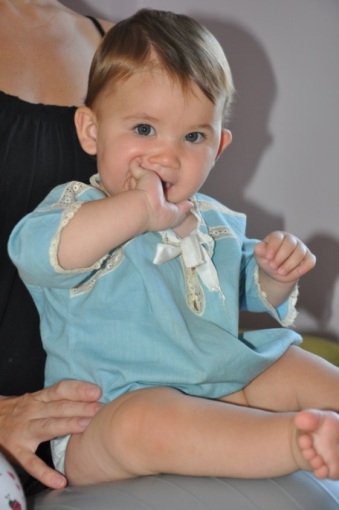
By the way, I made it just fine into adulthood without a chest full of childhood treasures but I do miss having just a few of my favorites that could take me back in time and put me in touch with a little girl I once was. So, when I got a little girl of my own, I started saving precious mementos of her early childhood with a little bit more zeal than others.
I saved a lot of of her baby clothes and kept most of the artwork she produced in nursery school, pre-k and kindergarten. Stored in archive-quality boxes were drawings, paintings, hand-made cards, crafts, and early school writings. A thought of parting with them never crossed my mind.
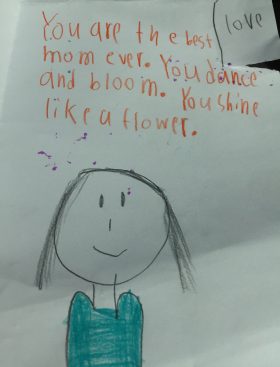
* * *
Two years forward and I am full speed ahead into minimalism and decluttering, completing 50 hours of practice to become a certified Kon Mari home organization consultant. And of course my home is my main training ground.
* * *
When I started putting my daughter’s room in order earlier this year, I was on a roll. Sorting through clothes was a piece of cake. Books were done in 2 hours. School-related papers were reduced to fit in just one drawer. Toys? Ok, toys took my daughter and me at least 3 separate sessions but we got through them as well and discarded a lot. No drama.
All that was left now was to go through two extra-large bins of sentimental items I dutifully set aside while tidying other categories. That’s because in Kon Mari method, sentimental items are considered the toughest to go through, and for that reason they are handled last, after you hone your skill for keeping only those items that spark joy and practice mindful and grateful parting with possessions that fulfilled their purpose in your life.
The first question I was confronting now was how I was going to keep up with new things my prolific artist and gentle soul will produce between now and the end of high school.
Even if I create the most perfect storage system in the world, what exactly is my end goal? To look through these things when I am old and lonely on a cold winter night? I don’t want to plan for that kind of future. To hand a treasure chest of childhood mementos to my daughter on her wedding day? That might be a better plan but at the rate I am collecting these items, it’s going to be boxes and boxes of good stuff that she will have to store in her tiny city apartment and schlep with her every time she moves, until her husband and she save up enough to buy a house, where she can finally park these boxes in an attic and never look at them again.
Or maybe she will look at them and more than once. And at those times when she does, will these items feel truly precious or she’ll wonder why in the world I kept them?
And if these boxes get ruined by a flood and she does not get them on her wedding day, will she still remember that she was a happy kid, loved by her parents and encouraged to explore everything that interested her? And what is more likely to create these kinds of memories – keepsakes or actual life experiences we are creating together right now?

I love what Marie Kondo says in her book “The Life-Changing Magic of Tidying Up” on the subject of sentimental items:
“It is not our memories but the person we have become because of those past experiences that we should treasure. This is the lesson these keepsakes teach us when we sort them. The space in which we live should be for the person we are becoming now, not for the person we were in the past”
Armed with this deeper insight and few realizations of my own, I started sorting through sentimental category looking to keep only what truly sparks joy and adding some of my own selection criteria based on my values:
Baby Clothes:
- Baby clothes means they stop at 24 months. Baby clothes represent a unique and truly fleeting phase in a child’s life while regular children’s clothes are much more ubiquitous and “so what” in nature.
- I allow for possible future additions – like an accessory from a costume my daughter performs in or a custom t-shirt made for a good cause, but I am not saving a fancy dress in size 7 because she wore it on her birthday
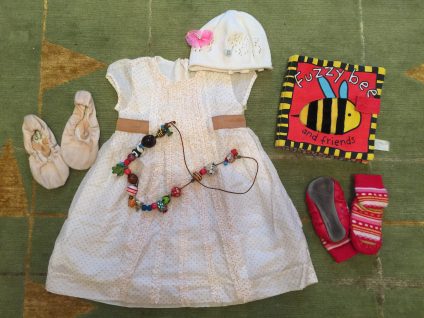
- I especially value keepsakes that represent milestones in my daughter’s development or are tokens of deep affection – in our case, it’s things like leather-sole slippers in which my daughter made her first steps, her first ballet shoes, a dress she wore on her second birthday party, which was a big social event in our family, a discovery necklace I made for her, her first see & touch book, etc.
- It will be one and just one box that fits easily on a top shelf in a typical closet. If it can’t fit new items, something will have to go.
Artwork:
When I spread my daughter’s artwork on the floor, it turned into a bright and happy carpet. Needless to say, it felt a little overwhelming to choose.
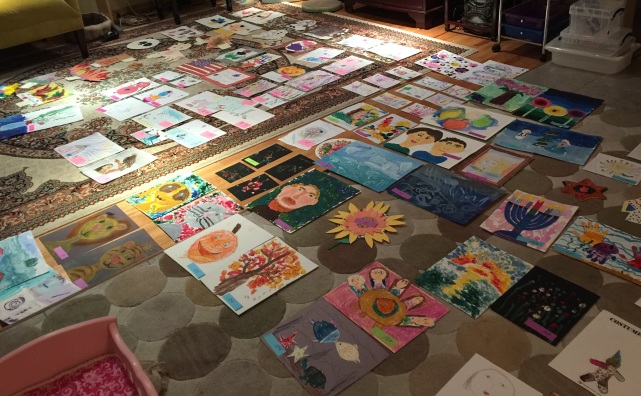
I parted with the obvious ones but the collection was still very large. I invited my daughter to go through them with me and she discarded maybe 10 more. There was still a lot left.
And then I had an idea. An art book! I need to turn these creations into an art book that can tell the story and stay in the family for years to come. What I was going for was something like this. Don’t you love the idea? I know!!

I researched options for producing a self-published art book and found a great article on How To Photograph Children’s Artwork because that would be your first step.
Armed with my husband’s Nikon, I perched myself on a chair and started taking pictures of each art piece, one by one. That took me an entire day and I went up and down that chair at least 100 times. It was a really good exercise for my legs but when I uploaded the pictures to my computer and looked at them the next day, I wasn’t exactly thrilled with the quality. They looked kind of flat and dull and well… didn’t spark joy.
But I don’t give up on the idea that I know is good. I kept doing my research and bumped into — are you ready for my best-kept secret? — this gem of a website.

Founded by two moms, who were also at a loss (just like me) at what to do with their children’s growing art collection, this company takes all of your precious art pieces and turns them into a beautiful hardcover art book your family and your child can enjoy and cherish for years.
After an elaborate attempt to produce an art book on my own, I was sold on the idea that a professional team will scan the images, create the best layout for each page, and print a beautiful, high-quality book for me. I ordered their prepaid Fedex box, packed my favorite pieces, added few post-it notes with instructions and off it went.
The art book that came back was just perfect. My daughter could not stop looking through it and she just loves showing it to her friends and our guests. And, it most certainly sparks a lot of joy for me.
After the art book is produced, you have an option of having your child’s creations sent to art heaven (good option) or have it returned to you. Ours came back at my request but now I was able to part with most of it easily and kept only few most cherished pieces. They are archived in a presentation book, which you can buy at Staples or at a specialty store like A.E. Friedman in New York.
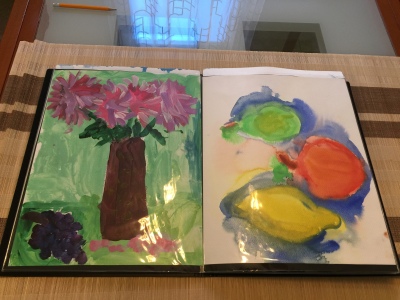
Keeping an extra presentation book handy is useful when you want to archive a special drawing during the school year on the go. We are saving fewer drawings these days but as our art portfolio grows, we’ll make a new art book every 3-4 years.
My daughter’s hand-made cards, performance playbills, and the most special hand-written cards we receive from relatives and friends are stored in a small pretty box. You can find really great ones at TJ Max and Marshalls stores. The important thing here is to remember that the message is received at the time when we open and read the card. At that point the card fulfills its purpose and the message is internalized by you deepening your relationship with the person who gave it.
Items that go into this small box in our home are very special and spark true joy.
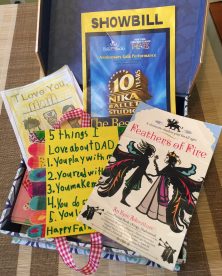
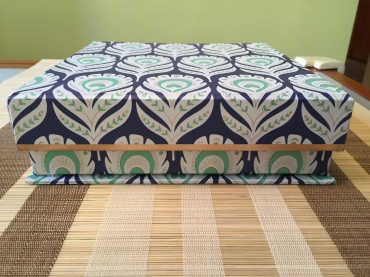
Any work of art, whether it’s Van Gogh’s or your child’s, exists only when it can be seen and experienced, so I am a big fan of creating an art gallery in the child’s room where her creations can be seen and admired. Find a wall that would be a great focal point in the room and create a collage of your child’s best or most favorite artwork mixing themes, textures, colors, and media. The more you mix, the more vibrant and alive it will come out. And there is no need for nails. Use clear tape, colorful washi tape, or removable mounting squares by Scotch sold at Staples. These last ones are my absolute favorites.
This is what our art gallery looks like. We update it with new pieces from time to time. The ones we take down, we either thank and part with or add to our archival presentation book.
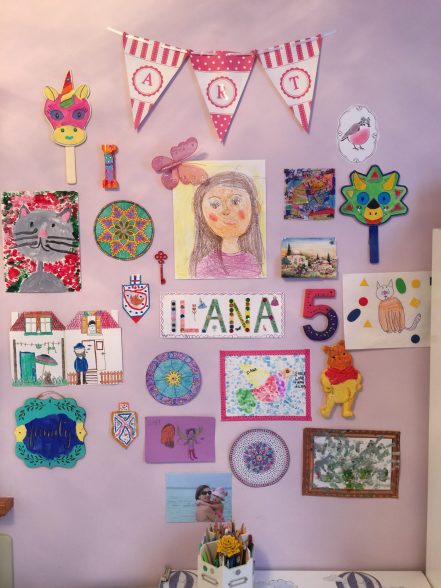
What remains are drawings, colored pictures, and collages that get produced by our little artists every single day. Throw them out quietly and you will have to face the music the very next day with some tough explanations to offer for your negligence. So what a parent to do? My answer is creating a temporary exhibition in a prominent place in your home, where the entire family can notice, discuss and enjoy their art.
We designated a narrow wall in our dining area to hang all kinds of temporary masterpieces. They stay up there for several days to few weeks and when I ask my daughter if we enjoyed them enough and can part with them, she almost always says Yes. It takes some practice to teach them to part with their creations but if you find a way to acknowledge their creative output in the first place, they will gladly adopt the new routine.

I hope you found some inspiration as well as some practical ideas for organizing your own sentimental collection. The reward of doing it is a sense of completion, appreciation for the person your child is becoming, and creating a mental and physical space for more great experiences and accomplishments to come.






This is such an awesome post!!! An absolutely fantastic idea to create the artbook (and good gift idea for grandparents 🙂 and love the idea of the wall. Thanks, Vlada! 🙂
LikeLike